-
Paper Information
- Previous Paper
- Paper Submission
-
Journal Information
- About This Journal
- Editorial Board
- Current Issue
- Archive
- Author Guidelines
- Contact Us
American Journal of Economics
p-ISSN: 2166-4951 e-ISSN: 2166-496X
2019; 9(2): 79-85
doi:10.5923/j.economics.20190902.06

Understanding the Economics of Problem-Solving. A Longitudinal Review of the Economic Influence of Inspiration Labs- Three Years Journey on Socio-Economic Solutions
Mohamed Buheji
International Inspiration Economy Project, Bahrain
Correspondence to: Mohamed Buheji, International Inspiration Economy Project, Bahrain.
| Email: |  |
Copyright © 2019 The Author(s). Published by Scientific & Academic Publishing.
This work is licensed under the Creative Commons Attribution International License (CC BY).
http://creativecommons.org/licenses/by/4.0/

We are living in a crowded creative world where problem-solving is not a commodity or a unique skill for leaders, but it is somewhat becoming a must for survival, for future foresight and competitive economic differentiation. Literature has a significant gap in the area of the economics of problem-solving, despite the recent rise of the term ‘solution economy’. In this paper, we shall explore the different types of socio-economic problems confronted in the three years’ journey of Inspiration Labs carried out the Inspiration Economy Project and in different countries. The discussion of each of the economic vectors for each problem is followed by a proposed framework on the ‘economic solutions vectors’ shows how to tackle any socio-economic problem-solving and lead to the economic development that supports the flourishment of the targeted communities.
Keywords: Solution Economy, Economics of Problem-Solving, Inspiration Labs, Inspiration Economy
Cite this paper: Mohamed Buheji, Understanding the Economics of Problem-Solving. A Longitudinal Review of the Economic Influence of Inspiration Labs- Three Years Journey on Socio-Economic Solutions, American Journal of Economics, Vol. 9 No. 2, 2019, pp. 79-85. doi: 10.5923/j.economics.20190902.06.
Article Outline
1. Introduction
- Imagine the world if we were able to double, triple, or even quadruple the number of problem solvers, the diversity of solutions, and the scale of social impacts. Imagine if every government and primary private sector opened up their toughest socio-economic challenges, or problems and directed their resources for many problem solvers and the social enterprises. Imagine how innovations would spread across the world would be and how we could tackle most complex problems in more inspiring outcomes. Buheji (2018 a, b) and Eggers and Macmillan (2013 a, b).We live in a creative world where many of us want to bring solutions to common world problems voluntarily. Therefore, the most resilient economy is the economy that would make such problem-solving economy grows to fill the spaces within this economy. The most resilient economy is the economy that would open the doors for creativity and would encourage the local small and medium businesses to embrace these solutions attempts.
2. Literature Review
2.1. The Solution Economy
- Solution economy, is a term developed by Eggers and Macmillan (2013 a) to solve the social problems from a multidisciplinary perspective which brings together different background practitioners from businesses, governments, philanthropy and social enterprises to tackle holistically a socio-economic challenge or problem that would serve many stakeholders or beneficiaries.
2.2. Solving Socio-Economic Problems through Inspiration Labs
- Inspiration labs were developed by the research, as part of an international project called Inspiration Economy, over three years ago, to tack socio-economic problems in a disruptive way through identifying first the problem vectors. The problem vectors exploit the opportunities out of the problem. The problem vectors help to tackle the problem effectively and ensure it has both economic and social impact. Buheji (2018a, b, c) and Buheji (2019a, b, c, d).
2.3. Acceleration of Solution Economy
- Solution economy target to accelerate the growing economies and help the problem solvers to support the government in achieving faster delivery of outcome-based solutions. These outcome-driven solutions are critical as governments are shrinking in size and NGO’s and Non-profit organisation are doubling in many countries. European Business Review (2016).Nyarko (2005) seen that knowledge can be captured through problem-solving. The capacity to capture knowledge through problems differentiate the competitive status for nations, or community and help them to master problems associated productivity. Thus, communities can improve their economic productivity and learn to produce new goods by observing how other communities are solving their problems and selectively transfer part of the solution to national problems.
2.4. Visualising the Economics of Problem-solving and Solution Economy
- With problem-solving and solutions economy we could help to open up services that meet the citizens’ choice, thus shifting the focus from results to the outcome. This help to thrive the socio-economic development efforts of any community. Visualising the economics of problem-solving help governments to provide room for creativity and differentiate their capacity in the delivery of social outcome. For example, if governments understand the economic return of solving the socio-economic problem, as the problem of Waste Pickers NGO’s they could be part of the transformation happening in India’s waste management program. The economy of the vectors of such problem comes from the increased demand of the middle class for organised, effective waste and environmental services management. These demands ensure innovative products and services that would guarantee the quality of life of all the beneficiaries in India and would help to enhance the economic return of such initiatives for recycling and eco-friendly projects. However, the government’s need to be willing to have more accessibility to important data for its partners that would differentiate its outcomes. The more government provide and collaborate on knowledge sharing the more we would witness a different solution economy that would also create a cultural transformation. Buheji (2018 a,b,c).
2.5. Issues of Problem-solving Solutions Economy
- Problem-solving and solution economy could be applied to any organisation, be it government, NGO’s or private sector. However, we would witness the significant differentiation of this economy in chronic complex issues such as poverty, hunger, unemployment, environmental management and youth migration, for example. Hussain (2013).Usually, the best economic solutions can inspire all type of sectors: business, government, philanthropic and social enterprises. Their currency of inspiration creates a primary value-added outcome. Hence, the benefit of problem-solving and solutions economy is that it would break the bureaucratic boundaries between the three major productivity sectors which means bringing in direct trillions of dollars in social benefits and commercial value, besides tremendous goodwill value. Design innovative new solutions could be the norm of future economies, where solutions would integrate low-cost health care with fighting poverty-related diseases. Thus, it is an economy where we could expect more solutions that would create markets for social goods and trade solutions instead of dollars to fill what citizens need. In recent years, an entire economy of societal problem solvers has emerged to tackle old problems in new ways. A rapidly growing and evolving solution economy now focus on social impact currency that if compared to the real value it would convert to millions. Hussain (2013).
2.6. How Solution Economy Can Solve Bigger Economic Problems?
- Christensen (2015) seen that solution economy is like a ‘solution revolution’ where governments are now tackling complex problems such as climate change, poverty and crumbling infrastructure through more partners. This collaborative economic practice could close the existing gap between government performance and citizen expectations, as it is improving ‘solution orientation’. Seattle’s FareStart is an excellent example of economic problems. This catering company and restaurant are staffed by cooks hired through a job placement program. It has flourished, supporting the delivery of more than five million meals to the disadvantaged. They also launched a café to train young baristas, combating the city’s high rates of youth unemployment and homelessness.Eggers and Macmillan (2013a) mentioned that significant enterprises, like Unilever, can be work on solution economy as market innovators, who are committed to addressing unmet community or consumer needs. For example, Unilever started to introduce products, that as soap, that target to meet the needs of people under poverty lines in countries in India and Africa. This initiative integrates both empowerment of entrepreneurs in rural India and increasing awareness of the importance of hand-washing, with an end goal of reducing infant mortality.Another example that Eggers and Macmillan mentioned for solution economy was Safaricom. Safaricom is leading integrated communications companies in Africa started a project that closes the gap of the enormous percentage of Kenyans who did not have access to banking in any form. By introducing Safaricom M-Pesa mobile banking phone app, 17 million Kenyans now can conduct business, receive entitlement payments and financial services. Another type of economic solution come from projects like Recyclebank. Such banks help to increase recycling rates by partnering with recycling bin maker and creating business incentivise recycling. The households, in the neighbourhoods in which Recyclebank operates, have recycling bins equipped with a chip that weighs the goods in the bin. Recyclebank credits the households account with points that can be spent on discounts offered by the network of business that Recyclebank has partnered with. This raised recycling rates into rates reached 90%. Hussain (2013). Hence, such sizeable private sector organisations can work on tackling social problems and bring in many goodwill values for community concerned beside the organisation.
2.7. Solution Economy vs Economics of Problem Solution
- Through partnerships between governments and different problem-solving players; key insights to outcome measurement can enhance the effectiveness of solutions and address more societal challenges. Thus, the solution economy could focus on integrating problem solvers and non-governmental contributors to bring in unique resources and creativity that would address the gap in societal needs. Usually, such problem solvers use disruptive approaches and value exchange solutions.Economics of problem-solving in Inspiration Labs focus on inspiration currency too. This help to create a differentiated socio-economic outcome. Solution economy also focus on impact currencies which also based on ‘value creation’ that enhances the social impact. Inspiration economy targets, in different ways, to create a transformation in communities through unique approaches of socio-economic solutions and redefining how complex issues could be solved, without extra or with minimal resources. Thus, inspiration economy is similar to solution economy which addresses societal problems, but through disruptive problem-solving that bring opportunities out of the problems, but not necessarily try to create a partnership between government and other sectors. In the solution economy, the economic value is created around the very problems considered to be sources of economic failures.
2.8. Cycle of Economy Thinking and Problem-solving
- Eggers and Macmillan (2013) mentioned about the new cadre of problem-solvers that are changing the global economy. Such problem solvers work on making societies face economic problems, which starts with facing how to make the best use of the limited, or scarce resources. The economic problem exists because, although the needs and wants of people are endless, the resources available to satisfy the needs and the wants are limited.Socio-economic problem thinking in inspiration labs help to create the main economic drivers that lead to practical solutions: goal setting, the relationship between problem-solving and capacity development, opportunity management, innovation behaviours, curiosity and rewards, performance improvement and reflections, as shown in Figure (1).
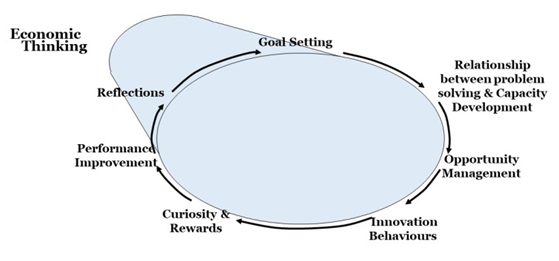 | Figure (1). Cycle of Economic Thinking |
3. Methodology
- In order to investigate the economics of problems solving through the three years experiential learning of the inspiration labs, eight case studies are reviewed for their problem vectors. Then, the analysis of this review is discussed and synthesised in relevance to literature. A proposed framework of the economic constructs or vectors of the socio-economic problems, then set up to the best way for diagnosing the economic problem outcome is presented.
4. Case Study
4.1. Role of Problem-solving Case Studies in the Economy
- Any economy is a tool for solving the mysteries of the problem investigated. This means that the economy helps us to build our ability for innovative behaviour, capacity for appreciating the opportunity recognition, having a variety of approaches to the economic problem and conflict mitigation and representation. Since economics is a “social science” the economy of problem-solving starts with seeing the gaps in the inconsistent assumptions, in order to enhance the abundance in solving problems using limited resources. Such problem economics is usually concerned with the problem of using ‘scarce resources’ to solve communities’ problems, or its challenges; such as re-focusing on means of producing (P1), attaining the greatest or maximum fulfilment (P2) and addressing society’s unlimited wants (P3). Based on the field visits and the profound observations, ‘opportunities management’ can enhance the problem outcome through problem scenario and storyboard, data collection, opportunities and ideas; till solutions are proposed. The influence on the economy starts with a methodology for exploring solutions and determining symptoms and specifications of the problem. Then, exploration of problem opportunities would work on building a story-line that would finalise the socio-economic outcome.The five constructs of economic solutions engineering economics are about observing the world with genuine curiosity and admitting it is full of mysteries. Then, by trying to solve those mysteries in ways that fit the human behaviour design, we can direct it towards a common purpose.Engineering solutions for problems and challenges can help to visualise solutions, ways of thinking, psychology and exploration questions. Economics of problem-solving bring in alternatives for managing conflict representations through constructs of observation (what is the essence of the problem?), exploration (depth of problem opportunities), prioritisation (seen and hidden opportunities), mindset (assumptions and behavioural change) and practices that (create models of Opportunities).Since economics is the ‘study’ of mankind needs, in the ‘ordinary business of life’, as Alfred Marshall mentioned we then to observe, absorb, apply, analyse and evaluate, create and reflect.
4.2. Case Studies that Reflect the Economic Influence of Problem-solving
- The following cases represent the experience of the researcher in exploring economic constructs (called problem vectors) that influence the economic and socio-economic Case 1- Problem Vectors of Poverty EliminationIn order to manage the economics of problem-solving of poverty alleviation and elimination, we need to utilise and optimise the demographics of the humanitarian stakeholders and where the humanitarian NGO realise their role to be moving people out of poverty and not only making people cope with poverty, as shown in Figure (2).
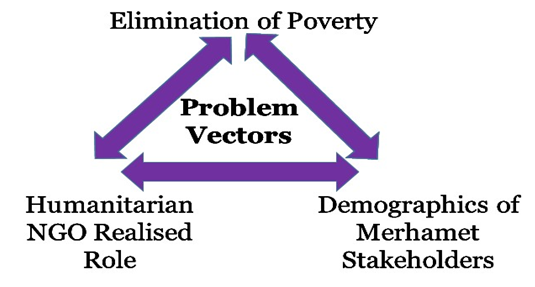 | Figure (2). Illustrates Vectors of Poverty Elimination |
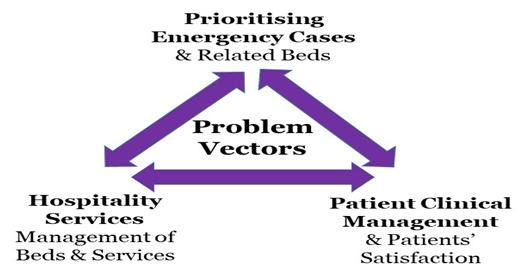 | Figure (3). Illustrates Vectors of Prioritising Emergency Cases Beds |
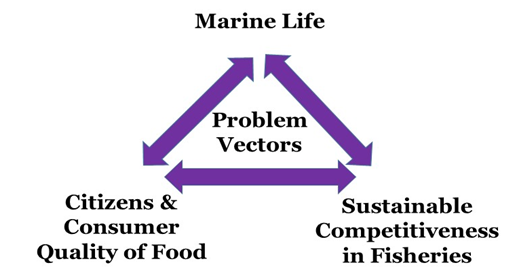 | Figure (4). Illustrate Vectors of Fisheries Improvement |
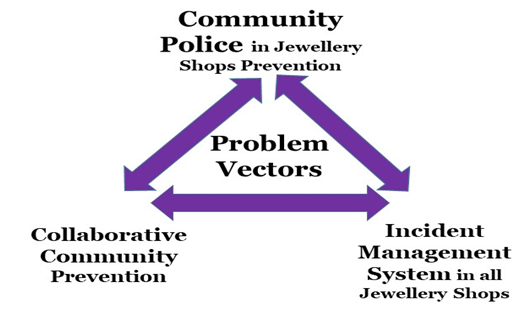 | Figure (5). Illustrates Vectors of Economic Stability & Jewellery Shops Improvement |
 | Figure (6). Illustrates Vectors of the Economics of Sanitary Blockage Solution |
 | Figure (7). Illustrates the Vectors of the Economics of Anxiety Management Solution |
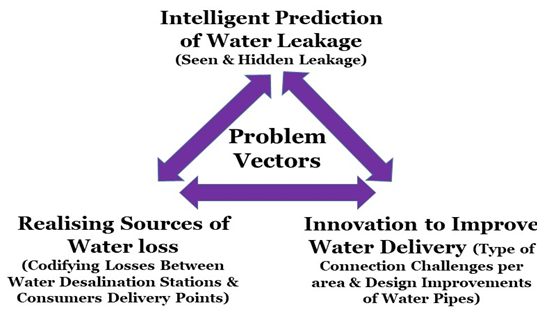 | Figure (8). Illustrates Vectors of the Economics of Sanitary Blockage Solution |
5. Discussion
5.1. The Economic Constructs of Socio-Economic Problems
- Reviewing the scarce literature and the eight cases that represent the summary of some of the problems solved by inspiration labs, show that the economics of problem-solution lies at the heart of economics. The techniques developed from the need to solve fundamental socio-economic problems facing all community while also ensuring optimisation of productive resources. Synthesis of all the cases shows there are three repeated constructs of any socio-economic problem-solving experience: 1-understanding the world, 2-understanding the relation of things, 3-understanding the human side. Figure (9) represents the economic constructs that might be part of any problem solving.
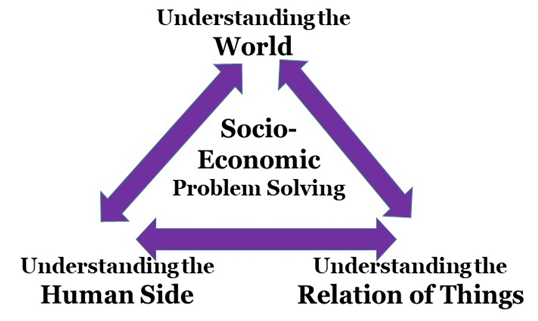 | Figure (9). Illustrates the Vectors and Constructs of any Socio-economic Problem |
5.2. Diagnosis of Economic Problem-solving Outcomes
- Diagnosis of problem outcome till the stage of discovery has its influence on the economic and the socio-economic status, especially when studying the relation of (area of problems vs area of diagnosis). As we move to an unknown and unclear area on this relation, we experience more area of socio-economic discovery thus more realisation about the problem solution and unlearning of any obstacles that would usually prevent us from making a high economic value solution, as shown in Figure (10).
 | Figure (10). Illustrates the best area for a Socio-economic Problem Discovery |
5.3. Economic Outcome Differentiation through Empathetic Story Scenario
- Reviewing all the eight cases presented one could see the empathetic scenario used to create a compelling story with clear economic outcome. Synthesis of these cases shows that what creates an economic outcome is the complete problem-solving cycle the differentiation that relates from the two directions: the scenario of the problem and its story, with the exploration efforts for problem opportunities. The relation of these two, as shown in Figure (11), i.e. the story visualised and the exploration efforts, help us to generate economically focused facts and ideas that can be identified and consolidated with specific learning areas in relevant to the problem solved.
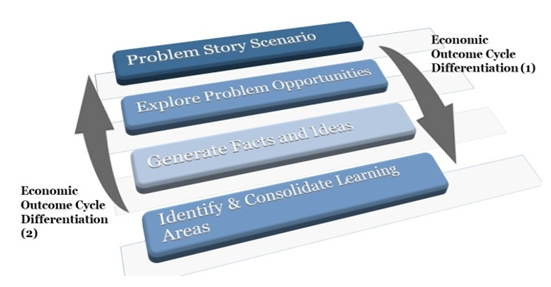 | Figure (11). Illustrates the Cycle Differentiation of the Socio-economic Outcome |
6. Conclusions
- This paper addresses a rare issue in the literature which shows the importance of problem-solving on the economy and the socio-economy. Despite there is not yet clear evidence of the relation between the problem vectors and the scenario of the problem story, the paper shows the repeated economic trend found from the inspiration labs in all the types of the problem solved. The economic effectiveness of understanding the world of the problem and the relation of things in the relevance of its human side is now clearly illustrated.Using the economics of problem-solving can help to spread the competition of solving socio-economic problems between problem solvers, innovating governments and private enterprises.
 Abstract
Abstract Reference
Reference Full-Text PDF
Full-Text PDF Full-text HTML
Full-text HTML